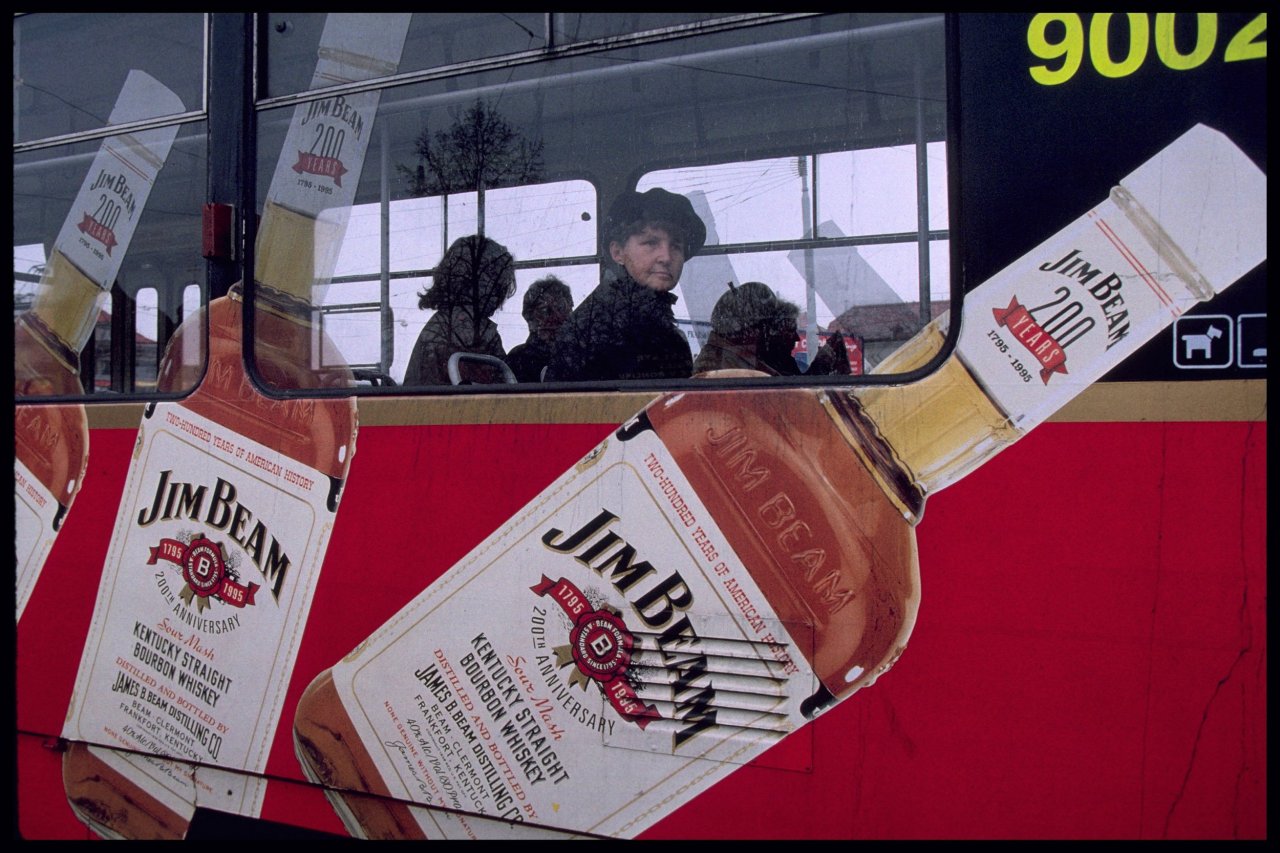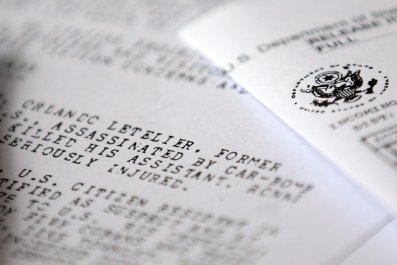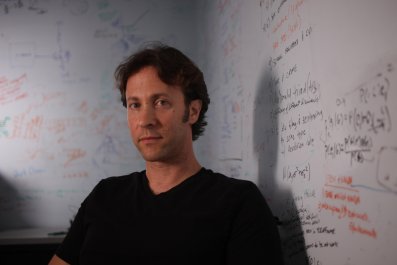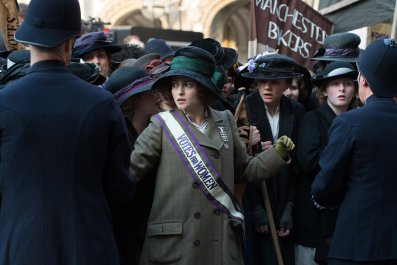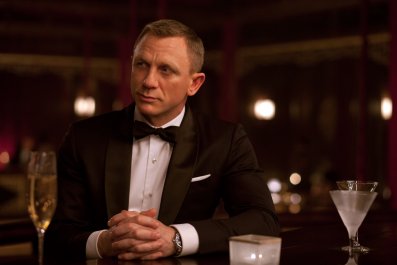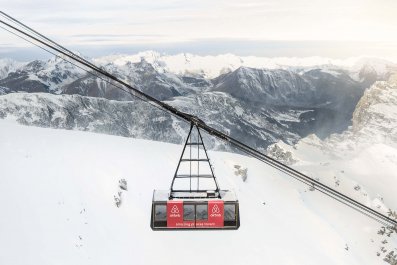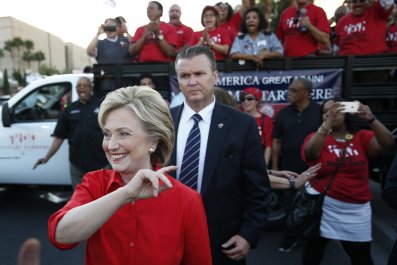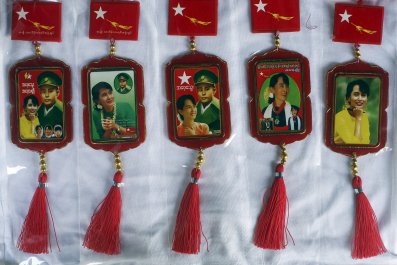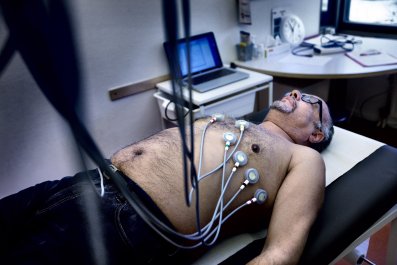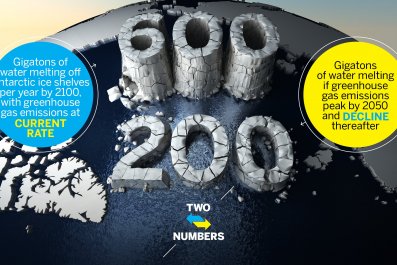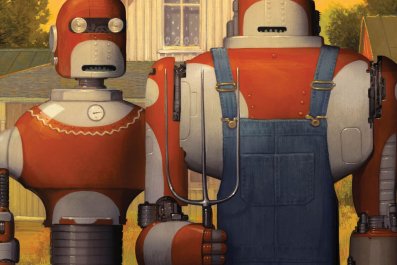I'm standing outside of a ballroom on the sixth floor of the Marriott Marquis hotel in midtown Manhattan, and I can barely move. Surrounding me on all sides are anxious men with glasses in their hands. Most of them are middle-aged, with hair in various stages of thinning or graying (or both). They have paid $325 or more for the privilege of standing here because, in about 15 minutes, the ballroom doors will open to reveal a paradise of brown liquor—103 different booths offering samples of 350 different types of whiskey.
I regret subjecting myself to this mob as early as I did, but there's no way out of it now. In a fit of desperation, I decide to check the badge I was given at check-in. Sure enough, it says what I hoped it would: WhiskyFest New York—VIP Admission. I shoulder my way through the gaps in the crowd, past a leather vest, a cowboy hat, a pocket of cigar stench someone dragged in from outside, until I reach a staff member. "Is there some sort of VIP line I can get in?" I ask, holding my badge up.
"This is the VIP line," he says. Since everything anyone could want to know about the recent American whiskey renaissance is contained beyond the doors ahead, I figure I can stick it out for a few more minutes.
Scotch, which is made primarily with barley, is what most people around the world think of when they hear whisky. American whiskey typically means bourbon or Tennessee whiskey, the most well-known producer of the latter being the Jack Daniel Distillery. Both are made from corn and are smoother and sweeter than scotch. Rye whiskey, made primarily with rye (obviously), has a spicier taste and is growing in popularity, but it's still a blip compared with bourbon. Larry Kass of the Heaven Hill Distilleries once told Imbibe magazine that they "spill more bourbon in one day than [they] sell rye in a year."
WhiskyFest New York is one of three similar events Whisky Advocate magazine will host in 2015. The others are held in Chicago and San Francisco, and, in 2016, they will add a fourth event in Washington, D.C., for the first time. WhiskyFest is billed as the longest-running such gathering in the country, though it's not the only one. Search the name of any metropolitan area in the United States along with whiskey and festival and you will not be disappointed. "There have been a lot of new whiskey events that have cropped up in the last five years," says Lew Bryson, an editor at Whisky Advocate and author of the book Tasting Whiskey. "I think that's probably indicative of the way things are going."
How are things going for American whiskey? In 2003, bourbon and Tennessee whiskey generated a little over $1.3 billion in revenue, according to the Distilled Spirits Council of the United States. By 2014, the number had more than doubled, to $2.7 billion. Over the past six years, from 2009 to 2014, annual revenue has increased by 46.7 percent. After the dominance of clear spirits caused the industry to finally bottom out in the late '90s, an uptick was inevitable, but the rise of American whiskey has been the result of more than just market correction. "People are looking for organic food, they're looking at locally made products," explains Bryson. "They're looking for family businesses and things that have been made the same way for generations. Whiskey has all of that, and it's real."
Reid Mitenbuler, author of Bourbon Empire: The Past and Future of American Whiskey, attributes the turnaround to the cyclical nature of the spirits industry, but also to our nostalgia for a bygone era, when life could be as simple as the glass of bourbon in your hand. Few pleasures are more American. "Whiskey, more than other spirit, has a heavy symbolism that's rooted in the American Revolution," says Mitenbuler. "That creates a romantic draw. It has a strong pull from a storytelling perspective."
Beam Suntory, the world's leading bourbon producer and the maker of Jim Beam, might be the most mythologized of all the American whiskies. At WhiskyFest, Beam's booth is in prime position right in front of the ballroom entrance, and festivalgoers are treated to samples of its latest innovations—from the pricey Harvest Collection to Jim Beam Devil's Cut, which is made by extracting bourbon from the wood of the charred oak barrels it's distilled in. Sitting in a chair next to the booth is Fred Noe, great-grandson of the brand's namesake and its current master distiller. He's a large man, bald and with a gray goatee that complements his thick Kentucky drawl. As the Jim Beam brand continues to expand, Noe is the living emblem of its down-home-y history. His presence at WhiskyFest assures consumers that the tradition espoused on the side of the bottle isn't just a marketing gimmick. "Consumers now want the story," he says. "They want to know what they're drinking."
In January 2014, Jim Beam made a bold move to expand when the distillery was sold to Japanese spirits company Suntory for $13.6 billion. Some consumers worried that one of the last purely American institutions would be corrupted by foreign influence, but so far Suntory has been hands-off, only serving to open distribution channels and expand bourbon's growing global appeal. In 2002, the United States exported $376 million in whiskey. In 2014, the number was over a billion dollars for the second year in a row.
But marketing bourbon to foreign consumers isn't the same as marketing it to Americans. "We've learned that what's popular here doesn't necessarily work everywhere else," says Noe. "Different flavors do well in different parts of the world, based on what society you're marketing to. That was a learning curve for us."
Countries such as Belgium, Brazil and, to a much larger extent, Australia have been primary targets for U.S. bourbon exports, and Suntory is continuing to cultivate a taste for American whiskey in Japan, a nation whose native whiskey is experiencing a similar explosion in global popularity. While Beam opted for sex appeal in marketing to U.S. consumers when it hired Mila Kunis as its domestic spokeswoman in 2014, for Japan it chose sophisticated cool: A sharply dressed Leonardo DiCaprio has appeared in multiple commercials for Jim Beam White Label.
Scotch is still the dominant whisky worldwide, but, as Mitenbuler says, "bourbon's star is rising." Jack Daniel's—technically not bourbon but Tennessee whiskey because of how it is "mellowed" through charcoal—is gaining ground on Johnnie Walker as the world's most popular whiskey brand, and the door is open for Jim Beam to continue to increase its market share as well. "All the bourbon companies are working on export outreach because, largely, it's pretty much untouched," says Bryson. "This is why the growth looks really good for the next 10 or 20 years."
The need to educate consumers has turned Noe from a country-boy bourbon distiller into a celebrity spokesman. He estimates that he spends 75 percent of his time on the road. A large portion of his travel stops, which take him around the globe, are at events like WhiskyFest, where the growth of the spirit is most evident. He's well-versed in the dynamics of such festivals, noting the increased diversity of the crowds, the careful ways in which drinkers plan their sampling routes and the endless cycle of fans asking him for pictures or to have a drink. For Noe, whiskey festivals are often similar, but they're consistently amusing. "If you just kind of stand back, you'll see some shit," he drawls. "You will see some shit."
Returning to the main ballroom after stopping by a high-priced tasting seminar Noe hosted, I realized what he meant. In short, everyone was drunk. Though each booth came equipped with a spitting bucket, they were underutilized, to say the least. Founders of craft distilleries—of which there are now more than 500 in the United States, compared with only a few dozen 15 years ago—excitedly explained to tasters why their products are different from the rest. The "peaty-ness" of certain brands is commented on, and the lengthy line to sample Pappy Van Winkle—the ultra-rare bourbon that can go for thousands of dollars a bottle—is bemoaned.
At one point, I came across a man standing in the middle of an aisle, open-mouthed, tasting glass in hand, with an enormous streak of red sauce down the front of his half-buttoned shirt. If he even noticed, he certainly didn't care. And in a way, this possibly blacked-out guy covered in food is a huge reason why bourbon has flourished in recent years. He is not someone who is detecting notes of vanilla; he is the indiscriminate whiskey drinker who will take it as it comes, decorum be damned. While scotch demands a certain attentiveness in the way it is consumed, bourbon—the sweetness of which makes it easier to drink—is far more versatile. Its appeal is broader than that of European whiskies, a sign that its growth potential is nearly limitless.
No one recognizes this more than Noe, who sees bourbon as something to be savored however one sees fit, whether it be through a high-priced cocktail or a shot thrown back at the end of a dive bar. "The versatility is one of the main things," he says. "The mixology world is keeping bourbon alive and well. The folks coming up are enjoying it. We've kind of hit the right lick."
Now it seems that the biggest obstacle for American whiskey makers is convincing the rest of the world to enjoy it as much as they do.



